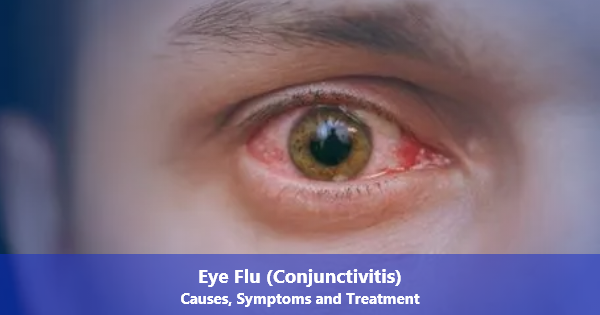Conjunctivitis, commonly known as “pink eye” or “eye flu,” is an inflammation of the conjunctiva, the thin, clear tissue covering the white part of the eye and lines the inside of the eyelid. It can be caused by various factors, and its symptoms, as well as treatment, may vary depending on the underlying cause. Here’s an overview:
Types and Causes of Eye Flu (Conjunctivitis):
Viral Conjunctivitis: This is often caused by viruses, similar to the ones responsible for the common cold. It’s highly contagious and can spread through contact with infected individuals or surfaces.
Bacterial Conjunctivitis: Bacterial infections, such as those caused by Staphylococcus or Streptococcus bacteria, can lead to bacterial conjunctivitis. It’s also contagious and can spread through direct contact or contaminated items.
Allergic Conjunctivitis: Allergies to pollen, dust, pet dander, or other environmental factors can trigger allergic conjunctivitis. It’s not contagious and is often associated with other allergic symptoms like sneezing and a runny nose.
Irritant Conjunctivitis: Exposure to irritants like smoke, chemicals, or foreign objects can cause irritation and inflammation of the conjunctiva.
Symptoms of Eye Flu (Conjunctivitis):
Redness in the white of the eye and inner eyelids.
Watery or mucous discharge.
Itchiness or burning sensation.
Swelling of the conjunctiva.
Sensitivity to light (photophobia).
Gritty feeling in the eye.
Crusting of eyelids or lashes, especially in the morning.
Treatment of Eye Flu (Conjunctivitis):
Viral Conjunctivitis: There’s no specific antiviral treatment, and it typically resolves on its own within a week or two. Cold compresses and artificial tears can help relieve discomfort.
Bacterial Conjunctivitis: Bacterial infections can be treated with antibiotic eye drops or ointments. It’s important to complete the full course of antibiotics prescribed by a healthcare professional.
Allergic Conjunctivitis: Avoiding allergens is key. Antihistamine eye drops or oral medications may help alleviate symptoms. Cold compresses can also provide relief.
Irritant Conjunctivitis: Removing the irritant and using artificial tears can help soothe the eyes. If necessary, a doctor may prescribe medication to manage symptoms.
In general, for all types of conjunctivitis:
Wash your hands frequently, especially after touching your eyes.
Avoid touching or rubbing your eyes.
Do not share towels, pillows, or personal items with others.
Replace eye makeup and contact lenses to prevent reinfection.
If you suspect you have conjunctivitis, it’s important to consult a healthcare professional, such as an eye doctor or general practitioner, for proper diagnosis and treatment. They can recommend the most suitable course of action based on the cause and severity of your symptoms.
How Eye Flu or Conjunctivitis spreads?
Conjunctivitis is an inflammation of the conjunctiva, which is the clear tissue that covers the white part of the eye and lines the inside of the eyelids. It can be caused by various factors, including viral, bacterial, and allergic reactions. The spread of conjunctivitis depends on its underlying cause:
Viral Conjunctivitis: This is the most common form of pink eye and is often caused by the same viruses that lead to the common cold. It can spread through direct contact with infected eye secretions or respiratory droplets from a cough or sneeze. It’s also possible to contract viral conjunctivitis by touching surfaces or objects that have been contaminated with the virus and then touching your eyes.
Bacterial Conjunctivitis: Bacterial infections can also cause conjunctivitis. It can spread through direct contact with infected eye secretions or through contaminated hands, towels, or other items that have come into contact with the infected eye.
Allergic Conjunctivitis: This type of conjunctivitis is not contagious and is caused by an allergic reaction to substances like pollen, pet dander, or dust mites. It is not spread from person to person.
If you have conjunctivitis, practice good hygiene and avoid touching your eyes, and consider staying home from work or school until the condition improves.
If you suspect you or someone else has conjunctivitis, it’s a good idea to consult a healthcare professional for an accurate diagnosis and appropriate treatment.
How Is Pink Eye Treated?
Your treatment depends on the type of pink eye you have. Symptoms of viral pink eye generally subside on their own. A cold, damp washcloth on your eyes can help alleviate symptoms until the condition passes.
Our ophthalmologist may recommend antibiotic drops or ointment to treat bacterial pink eye. Allergy medications can help clear up allergic conjunctivitis. It also helps to avoid contact with known allergens.
Conjunctivitis (Pink Eye):
Conjunctivitis, commonly known as pink eye, is an inflammation of the conjunctiva, the thin clear tissue that lines the inner surface of the eyelids and covers the white part of the eye. It can be caused by various factors, including viruses, bacteria, allergens, and irritants. Here’s some information about conjunctivitis:
Types of Conjunctivitis:
Viral Conjunctivitis:
Cause: Viral infections (adenovirus), often associated with colds.
Symptoms: Redness, watery discharge, itching, and discomfort.
Contagious: Highly contagious, spreads through direct contact.
Bacterial Conjunctivitis:
Cause: Bacterial infections (Staphylococcus aureus, Streptococcus pneumoniae, etc.).
Symptoms: Redness, thick yellow or green discharge, crusting of eyelids.
Contagious: Contagious until treated with antibiotics.
Allergic Conjunctivitis:
Cause: Allergens like pollen, dust mites, or pet dander.
Symptoms: Redness, itching, tearing, often accompanied by nasal allergy symptoms.
Contagious: Not contagious.
Irritant Conjunctivitis:
Cause: Chemicals, smoke, fumes, or foreign objects in the eye.
Symptoms: Redness, watery eyes, discomfort.
Contagious: Not contagious.
Prevention and Treatment of Eye Flu (Conjunctivitis):
Hygiene: Wash hands frequently, avoid touching eyes, and use clean tissues.
Avoid Sharing: Do not share towels, cosmetics, or eye drops with others.
Eye Drops: Over-the-counter lubricating eye drops can provide relief from symptoms.
Prescription Medications: Bacterial conjunctivitis requires antibiotic eye drops or ointments prescribed by a doctor.
Cool Compress: Applying a clean, cool compress can help soothe irritated eyes.
Allergen Avoidance: If allergic conjunctivitis is the cause, try to avoid allergens and consider allergy medications.
Rest: Give your eyes sufficient rest, and avoid wearing contact lenses until the condition improves.
Consult a Doctor: If symptoms persist, worsen, or you experience vision changes, consult an eye specialist.
FAQs about Eye Flu:
Q: Is pink eye contagious?
A: Viral and bacterial conjunctivitis are highly contagious, while allergic and irritant conjunctivitis are not.
Q: Can conjunctivitis affect both eyes?
A: Yes, conjunctivitis can affect one or both eyes.
Q: Can I go to work or school with pink eye?
A: It’s advisable to stay home until the contagious period passes, usually a few days after starting treatment.
Q: Can conjunctivitis cause vision loss?
A: In most cases, conjunctivitis does not cause permanent vision loss if promptly treated.
Q: Can conjunctivitis recur?
A: Yes, conjunctivitis can recur, especially if proper hygiene and precautions are not maintained.
Remember, proper hygiene and timely medical care are important to manage conjunctivitis and prevent its spread. If you suspect you have conjunctivitis, consult a healthcare professional or an eye specialist for guidance.
Be proactive and book your test at Oncquest Laboratories Ltd.
A favorite amongst clinicians, specialty hospitals, and other pathology laboratories, Oncquest is known for their second opinion and final diagnosis, using the most advanced technology and skills. Oncquest’ s national footprint spans over 40 Laboratories, 400+ Collection Centers and 2500+ Service Associates. It conducts over 4,000 different tests – from the routine to the most complex, spanning over 200 technologies. Oncquest has expertise in Genetic testing, Clinical Trials & patient support programs.





